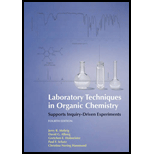
Laboratory Techniques in Organic Chemistry
4th Edition
ISBN: 9781464134227
Author: Jerry R. Mohrig, David Alberg, Gretchen Hofmeister, Paul F. Schatz, Christina Noring Hammond
Publisher: W. H. Freeman
expand_more
expand_more
format_list_bulleted
Question
Chapter 10, Problem 2Q
Interpretation Introduction
Interpretation:
The extraction procedure used to remove the acetic acid from the ethyl ether should be described.
Concept introduction:
A liquid-liquid extraction process uses two immiscible liquids for extraction. Immiscible liquids are insoluble in each other and form separate layers when placed in same glassware. It is result of differences in polarities of both liquids. The process of extraction is performed in separating funnel. There are many acids and bases present in the organic reaction mixture that can be separated by alteration in their solubilities.
Expert Solution & Answer
Want to see the full answer?
Check out a sample textbook solution
Students have asked these similar questions
What is the reason for using as little ethanol as possible to dissolve the crude product before recrystalliazation?
Diethylacetal can be detected by gas chromatography. How does this impurity arise in fermentation?
We want to extract terpenoids from an aqueous sample by continuous liquid-liquid extraction. Which of the following solvents is not suitable for this purpose? Why? Propanone (acetone), dichloromethane, heptane.
Chapter 10 Solutions
Laboratory Techniques in Organic Chemistry
Knowledge Booster
Similar questions
- Besides from petroleum ether, what other organic solvents are used for the recrystallization of diazoaminobenzene?arrow_forward1. You have been given a mixture of toluene,aniline and benzoic acid dissolved in chloroform.explain in detail with the aid of a flow diagram and reaction schemes,how you would separate the mixture into pure componentsarrow_forwardAn organic chemistry laboratory Extraction; the extraction of crude naphtalene- benzoic acid mixture. Naphthalene is a suspect carcinogen and is toxic to aquatic life. Find an alternative pair of molecules that adhere better to the principles of green chemistry and can be separated by extraction using green' solvents. (kindly answer fully)arrow_forward
- In the aspirin synthesis experiment, what is the reason for using as little ethanol as possible to dissolve the crude product before recrystallization?arrow_forwardIf 80% of a desired compound is extracted into the organic phase in each step (leaving 20% in the aqueous layer), how many extractions are necessary to ensure that at least 99% of the compound has been recovered in the organic phase? 1 extraction 2 extractions 3 extractions 4 extractionsarrow_forwardUsually, several different purification techniques are required to isolate a pure natural product from its source. What criteria would one use in choosing each step in natural product isolation?arrow_forward
- Write a balanced equation for the reaction of benzoic acid with hydroxide ion. Why is it necessary to extract the ether layer with sodium hydroxide?arrow_forwardWhy is it more difficult to recrystallize benzil when using hexane as a solvent instead of ethanol?arrow_forwarda student performed a recrystallization on 515 mg of impure compound using ethanol. After isolating the crystals, he obtained only 215 mg of pure product. Knowing that his sample was only slightly impure, he concluded that a significant amount of product was lost. Explain what likely happened and what he can do to recover his product.arrow_forward
- . Which method or methods can you use to obtain pure ethanol from ethanol-water mixture and to obtain limonene from lemon? Explain the methods you will use, along with the basic principles and relevant experimental setups.arrow_forwardWhat is the chemical reaction when completing extraction experiment and using 100mg Benzoic Acid, 2ml H2O and CH2Cl2 each? What is the chemical reaction when completing extraction with 4-chloroaniline and adding in HCl?arrow_forward5. 1. What is the purpose of testing distilled water and laboratory ethanol in the testing of ethanol? 2. During the experiment, you recorded the vapor temperature of the samples. Does the literature B.P. of ethanol correspond to the recorded temperatures? Why or why not? 3. Based on the iodoform test, did your distillate portion contain ethanol and/or water? Explain?arrow_forward
arrow_back_ios
SEE MORE QUESTIONS
arrow_forward_ios
Recommended textbooks for you
 Macroscale and Microscale Organic ExperimentsChemistryISBN:9781305577190Author:Kenneth L. Williamson, Katherine M. MastersPublisher:Brooks Cole
Macroscale and Microscale Organic ExperimentsChemistryISBN:9781305577190Author:Kenneth L. Williamson, Katherine M. MastersPublisher:Brooks Cole EBK A SMALL SCALE APPROACH TO ORGANIC LChemistryISBN:9781305446021Author:LampmanPublisher:CENGAGE LEARNING - CONSIGNMENT
EBK A SMALL SCALE APPROACH TO ORGANIC LChemistryISBN:9781305446021Author:LampmanPublisher:CENGAGE LEARNING - CONSIGNMENT

Macroscale and Microscale Organic Experiments
Chemistry
ISBN:9781305577190
Author:Kenneth L. Williamson, Katherine M. Masters
Publisher:Brooks Cole

EBK A SMALL SCALE APPROACH TO ORGANIC L
Chemistry
ISBN:9781305446021
Author:Lampman
Publisher:CENGAGE LEARNING - CONSIGNMENT